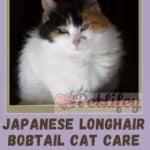
The Japanese Bobtail cat exists in two versions, the long-haired (longhair) and the short-haired (shorthair); he is a medium-sized, slender cat.
Its muzzle, topped with eyes with the characteristic shape and disposition, its high cheekbones and its long muzzle give it a particular aspect, which other oriental cats do not have, and which cannot be defined other than “typically »Japanese (in reality its distant origin is Chinese).
Its most marked characteristic, however, is its tail which has the particularity of being rolled up on itself in the shape of a pompom of hairs which go out in all directions. In addition, Japanese has a very extensive “vocabulary” which he expresses in a modulated voice, which makes him pleasantly talkative.
His gift for vocalizations and his character, really sociable and affectionate, make him a very good companion cat.
The origins of the Japanese Bobtail Cat
In Japan, there are representations of a cat very similar to the current Japanese Bobtail cat (drawings, statues, temples or engravings), some even dating back more than ten centuries.
Ancient documents were also found which spoke of it, but without clearly specifying the general shape or the length of the tail. The cat was depicted with the left front paw raised in salute, in ceramic statues called maneki-neko, which are a symbol of welcome.
Curiously, however, the origin of this cat is not Japan, because it came there more than a thousand years ago, from China; Another curious fact, today very few Japanese Bobtails are found in the Empire of the Rising Sun.
Appearance of the Japanese Bobtail Cat
It is a cat of medium size and lanky in body and bones. Its musculature is strong but not massive, on the contrary it is thin and flat. The head appears long and thin, but in reality it forms an almost perfect equilateral triangle, with soft, curved lines.
The muzzle, neither pointed nor blunt, is full and round. The eyes are large and oval, well separated and, if viewed in profile, they reveal a very pronounced slant.
The ears, set wide apart and set at a right angle to the head, are large and erect, although in resting position they give the impression of being folded forward.
The body is long and thin; the strong musculature is clearly visible; the legs are proportionate to the body and long, slender but not slender; even though the hind legs are longer than the front ones, when this cat is in a relaxed position, the torso is horizontal and does not rise backwards. The feet are small and round.
The tail, with its characteristic rolled-up position and the long hairs facing in all directions which create the pompom or rabbit tail effect, is always very thick, even among long-haired Japanese Bobtails.
The pompom gives the impression of starting at the base of the backbone and masks the underlying bony structure of the tail, which is formed of strong and rigid bones; it can be formed from a single piece or from several (in this case, it is rolled up “in an elbow”).
The dress of the long-haired Japanese Bobtail cat is quite close to the body and forms “pants” around the hind legs.
The cat can also have a nice ruff; the coat is medium to long in length and is soft and silky, but virtually devoid of undercoat. Even the shorthaired Japanese Bobtail has almost no undercoat; among short-haired cats his is of medium length, soft and silky.
Coat color of the Japanese Bobtail Cat
The colors are the same for the two varieties: all are admitted but the preferred ones present contrasts and violent tiger patterns; the leather of the nose and that of the fingers must harmonize as much as possible with the color of the hair.
The most popular is the traditional white, black and red, known as mi-ke, but two-tone are also popular. The color of the eyes can be in harmony with that of the dress or quite different.
The character of the Japanese Bobtail Cat
The Japanese Bobtail cat has a strong personality, it is serene and affectionate; good company, intelligent, friendly and cheerful, it is also a very good hunter. Very lively, it is very curious about everything around them and adapts very well to living in an apartment; all these qualities make him an attractive cat.
Hug:
Particularly human-oriented, no wonder it’s very affectionate! But it is not a cat that will stay on its human’s lap for a long time. It prefers to move!
Player:
Extremely playful, it can have fun alone with their toys as well as want to play a game of “fetch!” With their human. In fact, if we omit to play it, there will easily be “games” in the house, suitable … or not!
Calm:
They much prefers to participate in the adventure, or, even better, to create it!
Intelligent:
Curiosity and liveliness make them a resourceful and very intelligent cat. It learns things and makes connections very quickly.
Fear / Suspicious of
Strangers : It adapts quite easily to strangers, but this character trait varies greatly from one individual to another.
Independent:
Although it is attached to their human, it likes to go about its own business … and it can be very busy!
Behavior of the Japanese Bobtail Cat
Talkative:
It is known to be very talkative. In fact, it is rather recognized as a good singer, because both its “vocabulary” and its vocal register are pleasantly extended and make its vocalizations a pleasure to listen to.
Greedy / glutton:
It is not a picky eater. Watch out for being overweight!
Need for exercise:
Active, it has a great need to exercise and to play. Its short tail does not prevent him from jumping and keeping his balance at all.
Runaway:
It is not very runaway, but curiosity or the lack of stimulation in the house may lead them to go exploring outside.
Compatibility of the Japanese Bobtail Cat with other animals
The Japanese Bobtail with Dogs:
It adapts easily to the company of dogs, as long as it is given time to adapt!
The Japanese Bobtail with Other Cats:
It is rather recognized as appreciating those of its own breed only, but with the proper introduction all cohabitations are possible.
Japanese Bobtail with Kids:
It is known to love children. Maybe it’s its playful side? Still, you should never forget to watch to limit the risk of incidents between animal and child.
The Japanese Bobtail with the Elderly:
As it is very active and requires a lot of interaction, the adopter must be ready to give it this attention. Otherwise, beware of feline nonsense! It’s not a sofa cat!
Price of the Japanese Bobtail Cat
On average, a Japanese Bobtail retails for between 1000 USD and 1500 USD on purchase. Then, around 50 USD per month will have to be disbursed for his monthly needs. However, you should know that there are very few breeders of this breed in Europe and that the price could be different if it is necessary to bring it from the United States, the country where it is most found.
Maintenance of the Japanese Bobtail Cat
Grooming:
The absence of undercoat in its coat makes it very easy to maintain. One brushing per week is enough for them. Both the short hair version and the long hair version will not tie knots thanks to the silky texture of the hair.
Hair Loss: Hair
loss is minimal in the Japanese Bobtail.
Food of the Japanese Bobtail Cat
The dietary needs of Japanese Bobtail are simple: good quality food offered in sufficient quantity to meet its energy needs without going overboard (and the risks of being overweight associated with this excess).
Finally, its meals should preferably be served at interactive stations in order to satisfy their need for mental and motor activities.
Caring for the Japanese Bobtail Cat
The Japanese Bobtail cat is a healthy and robust cat that does not require special care. Grooming is made very easy by the fine and soft structure of the coat and the almost total absence of undercoat.
Health of the Japanese Bobtail Cat
Life expectancy:
The Japanese Bobtail lives an average of 16 years.
Resistant / robust:
The lack of undercoat can make it a little more sensitive to cold temperatures. But, its coat being rather waterproof, it appreciates water and it generally adapts well to warmer temperatures.
Tendency to gain weight:
The Japanese Bobtail cat has a small tendency to become obese. You must therefore pay attention to your diet and exercise.
Frequent diseases:
We do not know of any particular genetic disease. It can obviously develop all the physical and oral pathologies of domestic felines, but he is generally in good health. The dominant gene responsible for its single tail is different from the Manx gene and is not associated with spinal abnormalities.
Reproduction:
There is no particularity concerning its reproduction. The only permitted marriages are between Japanese Bobtail, but it is possible to mix Shorthairs and Longhairs, since they are one and the same breed.
Good to know
The Japanese Bobtail is an integral part of Japanese culture and folklore. The “ordinary” cat often represents a clever spirit but, when it has only a small piece of tail, that changes everything for the Japanese: it then becomes auspicious!
The Maneki-Neko illustrates this concept perfectly: literally meaning “inviting cat”, it is a statue of a very short tailed cat, sitting, which raises a paw near the ear.
It is supposed to bring happiness and fortune to the place where it is installed and can be found in almost all homes and businesses. The Maneki-Neko is, of course, a Japanese Bobtail!
Another representation of the breed is the well-known Hello Kitty!






